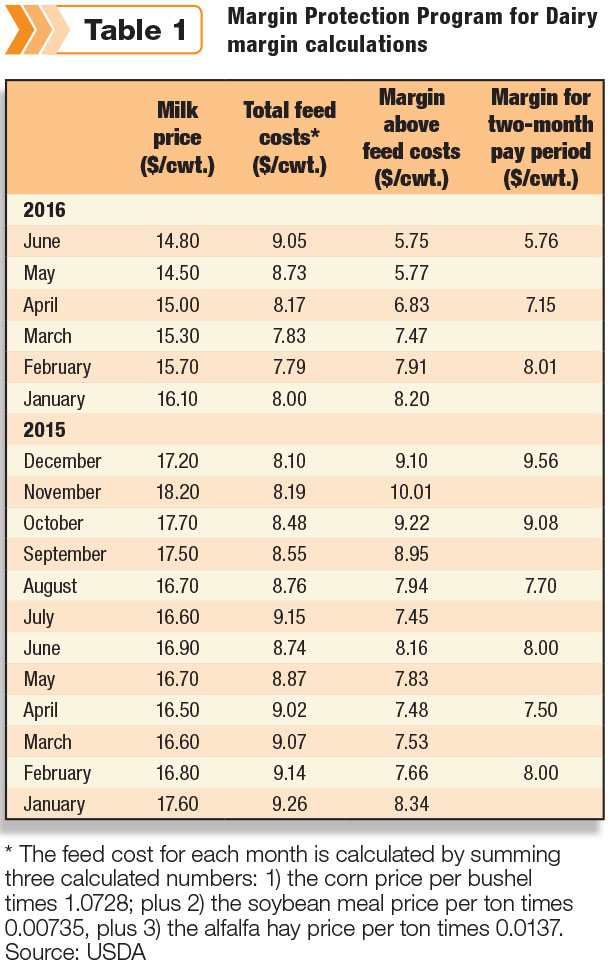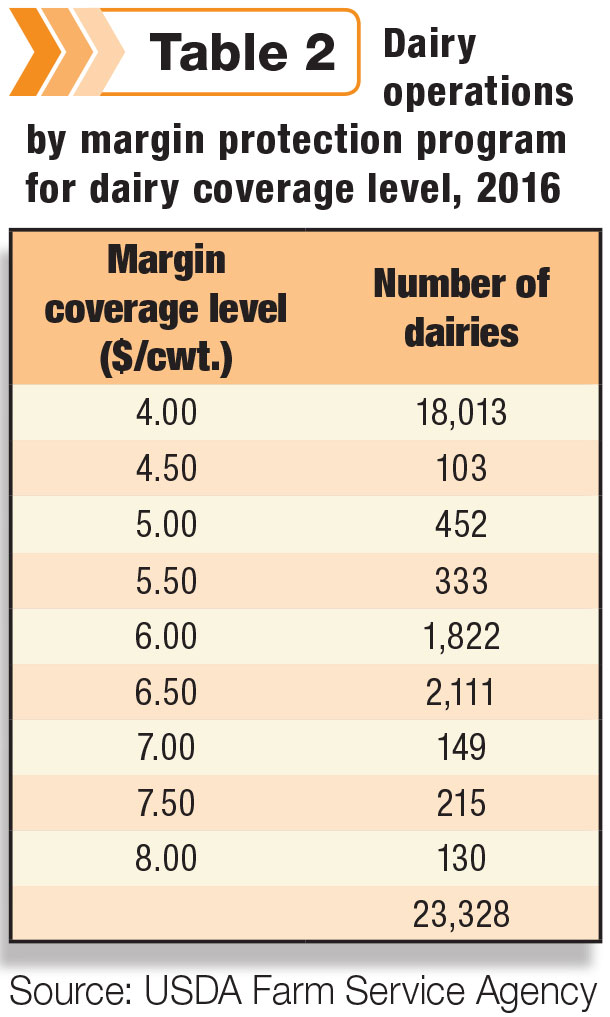The Margin Protection Program for Dairy (MPP-Dairy) will provide indemnity payments to dairy producers with milk income over feed cost margins insured down to $6 per hundredweight (cwt) level, according to the USDA Farm Service Agency (FSA).
USDA’s latest Agriculture Prices report provided milk and feed price factors for June, the second half of the May-June pay period margin calculations.
At $14.80 per cwt, the U.S. average milk price was up slightly from May, halting a six-month decline. However, higher feed prices took a bigger bite of June’s milk income.
June margins calculated
Under the MPP-Dairy formula, feed costs were pushed higher by another $32 per ton jump in soybean meal (to $408.57) and a 14-cent per bushel increase in the corn price (to $3.82). Those increases more than offset a $5 decline for alfalfa hay (to $142 per ton). The soybean meal price has increased to nearly $135 per ton since February.
National average feed costs in the June MPP-Dairy calculation totaled $9.05 per cwt, leaving an income over feed cost margin of just $5.75 per cwt (Table 1).

When combined with May milk and feed prices, the two-month margin was calculated at $5.76 per cwt, down $1.39 from the March-April pay period and the lowest in the program’s short history.
Under the 2016 MPP-Dairy program, 4,427 dairy herds have margins insured at $6 per cwt or higher, about 19 percent of the 23,328 total MPP-Dairy participants (Table 2).
In California, 18 of the state’s 1,181 MPP-Dairy participants will see May-June payments, 13 of which are insured at the $6 per cwt level, according to Milk Producers Council general manager Rob Vandenheuval.

The May-June payment rates (per cwt) calculated by FSA at insured margin trigger levels are:
- $8.00: $2.24
- $7.50: $1.74
- $7.00: $1.24
- $6.50: 74 cents
- $6.00: 24 cents
Eligible farmers will receive payments on one-sixth of the annual milk production history. Payments will be determined by the individual producer coverage level and percentage of annual production covered under MPP-Dairy, less a 6.8 percent federal budget sequestration in place until 2023.
USDA Farm Service Agency checks are likely in mid-August, according to Alan Zepp, risk management program manager at Pennsylvania's Center for Dairy Excellence.
Example herd
A dairy herd with a margin insured at the $6.50 per cwt level would see an indemnity payment of about 74 cents per cwt.
Using an example herd of 100 cows with a production base averaging 22,222 pounds of milk per cow per year, a herd protecting a $6.50 per cwt margin on 90 percent of annual milk production would see a May-June indemnity payment of about $2,465, minus the budget sequestration estimate of $180, for a payment of $2,285.
Looking ahead
Stronger milk futures prices have improved forecasted MPP-Dairy margins for coming months, making future payments less likely. As of July 29, pay-period projections were: July-August – $8.19; September-October – $9.93; November-December – More than $10.00; and the first half of 2017 in a range of $9.50-$9.80 per cwt.
2017 MPP-Dairy enrollment now open
The enrollment period for the 2017 MPP-Dairy program is currently underway at USDA FSA offices. Producers have until September 30 to select coverage levels and adjust milk production history.
Although not yet approved at Progressive Dairyman’s publishing deadline, congressional agriculture leaders asked USDA to extend the 2017 MPP-Dairy enrollment period to December 31.
House Ag Committee ranking member Rep. Collin Peterson (D-Minnesota) and chairman Rep. K. Michael Conaway (R-Texas), along with Sen. Debbie Stabenow (D-Michigan), ranking member of the Senate Ag Committee, sought the extension in a letter to USDA Secretary Tom Vilsack.
The lawmakers said the extension would allow farmers to make more informed decisions regarding income margin coverage and improve program participation.
Check with your local Farm Service Agency office for any deadline changes.
Premium payment reminder
One reminder before heading into 2017: 2016 MPP-Dairy coverage year premium fees are due on or before Sept. 1, 2016.
Failure to pay premium fees by the due date will result in coverage automatically defaulting to the $4 per cwt level; loss of any potential payments at buy-up levels through the remainder of 2016; and loss of coverage for the next calendar year.
MPP-Dairy changes
USDA previously announced several program changes.
One change, implemented retroactively for 2016, ensures all farms enrolled in MPP-Dairy will receive catastrophic coverage at the basic $4 per cwt margin level on 90 percent of their production history. Participants will have the ability to purchase buy-up coverage to protect from 25 percent to 90 percent of production history at levels from $4.50 to $8 per cwt, in 50-cent increments.
While a majority of farmers using the program in 2016 are protected at the $4 level, for those who bought up a higher level of margin, but did not cover 90 percent of their milk production, this change ensures they are still receiving catastrophic protection on the maximum level of production allowed by the MPP.
Adding family members, production
USDA also announced a rule change to allow a farm’s production history to be restructured to accommodate new family members joining a particular dairy operation. This will accommodate the intergenerational transfer of production history for children, grandchildren, and their spouses to join a dairy operation. Any dairy operation already enrolled in MPP that had an intergenerational transfer occur will have an opportunity during the 2017 annual coverage election period to increase the operation’s production history up to 4 million pounds per year.
Each participating dairy operation is authorized one intergenerational transfer at any time of its choosing until the current program expires at the end of 2018.
One final note
There has been no action on bill (H.R. 4896) requiring USDA to calculate MPP-Dairy margins for individual states. It was referred to the House Ag Committee’s livestock subcommittee in late April. PD

-
Dave Natzke
- Editor
- Progressive Dairyman
- Email Dave Natzke




